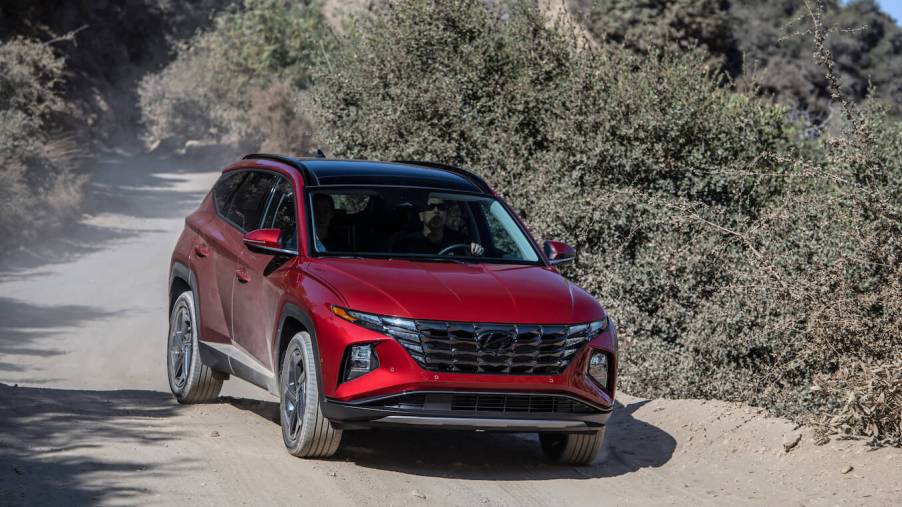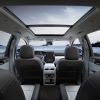
Hyundai Is Still Investing Plenty Into Its Real Money-Makers
Hyundai entered 2023 as one of the few car brands on the upswing after increasing its sales figures by two percent over 2021 and experiencing its best fourth quarter ever. That momentum continued into this year, with three of its models finding an expanding audience of new drivers. Hyundai is acting on this moment by investing hundreds of millions of dollars into its manufacturing plant in Alabama.
Hyundai manufacturing plant receives $300 million investment
Last month, Hyundai announced plans to invest $290 million in the Montgomery-based manufacturing plant responsible for producing its SUVs like the Santa Fe and Tucson. $190 million of that sum is designated specifically for tooling and equipment upgrades for the upcoming fifth-generation Santa Fe.
In a Hyundai press release following the announcement, local government officials and corporate spokespeople were both effusive about the development and its impact on the community.
“Today, the legacy of the Santa Fe continues with HMMA investing $190 million dollars to prepare our assembly plant for the next generation of this popular SUV,” said Hyundai Motor Manufacturing LLC President and CEO Ernie Kim. “An additional $100 million dollars will be invested to support ongoing production of the Tucson SUV and Santa Cruz Sport Adventure Vehicle.”
“The momentum happening in Montgomery is truly remarkable, with Hyundai being one of our esteemed partners that has played a pivotal role in driving this momentum forward,” affirmed Montgomery Chamber Board Chairman LaBarron Boone. “The people of Montgomery and the wider River Region have benefitted from our partnership with Hyundai for more than two decades. During that time, there have been 16 expansions of HMMA, an investment that totals $3.377 billion at just the Montgomery plant alone. With today’s announcement, Hyundai continues to be a leading driver of the momentum in Montgomery.”
Production on the new Santa Fe will begin later this year, joining the Tucson, the Santa Cruz Sport Adventure Vehicle, and both the electrified and gas versions of the Genesis GV70 luxury SUV on HMMA’s assembly line.
Hyundai’s 2024 slate includes electric and gas-powered models
Hyundai’s product line has one foot in an electric-first future and another in the present day where gas power remains the standard.
For the 2024 model year, the company adds a few new safety features to the Ioniq 5 and introduces a fresh redesign for the Kona, introducing more interior space, an upgraded 12.3-inch touchscreen, and a 48-kWh battery option. Hyundai also made small changes to the hybrid models of the Elantra and Sonata.
The Santa Fe and the Tucson have been the brand’s standard-bearers this year, and Hyundai is making moves to ensure that both vehicles receive enough updates to continue running smoothly.
The 2024 Santa Fe gets a new interior and exterior design that draws similarities to a Land Rover. It now features three rows of seating with a larger wheelbase and tailgate opening. Meanwhile, the Tucson adds new standard safety features such as rear-side airbags, blind-spot monitoring, and lane-keeping assist. Hyundai also adds new model colors and includes a 10.3-inch touchscreen to the SEL Convenience, XRT, and Limited trims as standard.
The time to go all-in on electric vehicles has yet to arrive
The transition to EVs as the most common type of vehicle feels inevitable, but Hyundai is right to support its best-selling models while they remain popular.
The automaker couldn’t opt for a different strategy. Hyundai is a giant corporation that exists to make money, so of course, they’re going to back the Santa Fe and Tucson for as long as the sales are good. However, the fact that there’s no short-term financial argument in favor of prioritizing EVs is indicative of an issue affecting the entire auto industry.
As more car companies produce their own electric vehicles, the technology under the hood continues to advance on a regular basis. Unfortunately, the infrastructure to support greater marketplace penetration for EVs has not developed at the same pace. Charging stations remain a rarity in most of the country, and the veracity of lithium-ion batteries as a reliable and environmentally safe power source is now in question.
Drivers have picked up on this predicament, with some EV adopters giving up the ghost and returning to gas-powered cars.
For all the good intentions behind the push for electric vehicles, the world still might not be set up for most people to use them.


